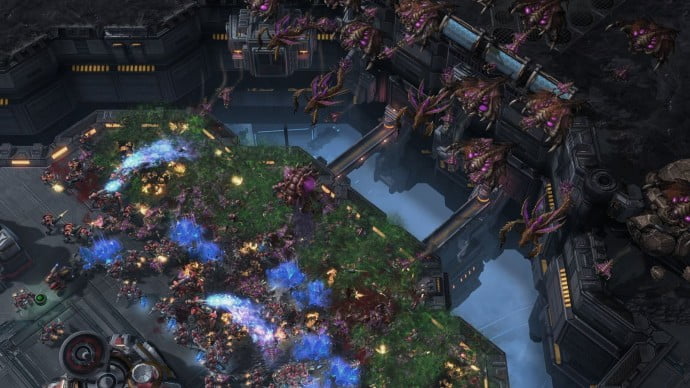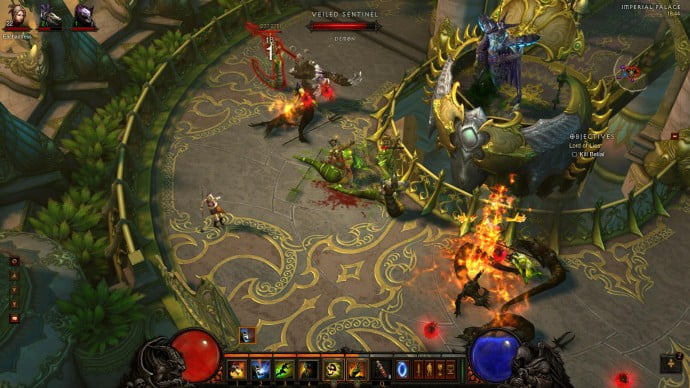In 1991, Synapse and Silicon, a new California-based game developer, was founded by three university graduates who would later become known as pioneers of competitive gaming. Michael Morhaime, Allen Adham, and Frank Pearce would soon accredit themselves with massively popular experiences such as StarCraft, Diablo, World of Warcraft, and most recently, Hearthstone. Known now as Blizzard Entertainment, Inc., they’ve become synonymous with online gaming and remain one of the most prominent and influential developers in the industry. Each of their releases have reigned supreme in their respective genres, but in recent years, they’ve faced major competition – StarCraft in particular.
SC: Brood War, a game often regarded as the world’s most successful e-sport, remains one of Blizzard’s crowning achievements. It established major sponsorship deals and even had two TV channels within Korea dedicated to showing professional matches. Players of these matches were treated with stardom, not unlike world class football players. Slayers Boxer, one of the more famed players, had a fan club consisting of half a million loyal followers. Avid gamers continued to follow the e-sport for fourteen years, an entire two years after its successor, StarCraft 2: Wings of Liberty, took over the reins.
Released to rave reviews in 2010, Starcraft 2: Wings of Liberty left many to assume that Blizzard’s dominance of the competitive gaming scene would continue unopposed. However, other titles such as League of Legends and Dota 2 have left the once dominant franchise trailing behind.
StarCraft was knocked from its perch for many reason, one being the contentious issue with its outdated pay-to-play scheme. Those interested in the title can purchase it with an upfront cost, a tried and tested formula. However, League of Legends uses a free-to-play model, allowing players to purchase optional aesthetic wares for characters. Blizzard disregarded this new pay-model, and who could blame them? Getting players to invest in purely superficial items, with no bearing on gameplay, seemed like a poor way to generate income. However, Riot Games were able to draw in crowds which otherwise may have shown little interest in their title; whereas StarCraft needed to work harder to convince those on the fence to part with their hard earned cash. Whether freemium games make more money this way isn’t clear, but the interest that it spurs in new online titles has been undeniable. It only takes a quick glimpse at the viewership of free-to-play titles on streaming sites like Twitch, or downloads from Apple’s app store to see how influential it can be.
The next iteration in the StarCraft 2 trilogy, Heart of the Swarm, required players to own the first tile in the series, sectioning off newcomers from this new title. It didn’t stop it from becoming the fastest selling PC title of 2013, but despite its successful launch, it lost momentum against its competition. Blizzard’s rigid model is one that worked adequately for its earlier titles, but it simply doesn’t bring in the same crowds that these newer games can. Maybe they’re content with that. There’s little doubt that StarCraft is still considered gaming nirvana for its loyal fans, and that its globetrotting popularity is still intact. But its business model has kept many from joining the fray, in turn keeping it from extending its gaming brilliance outside of the established fanbase.
It isn’t purely an issue with cost. As mentioned earlier, Wings of Liberty released to widespread acclaim, but there were some notable issues that it was slow to address. One of these was the way the game didn’t lend itself towards competitive play.
StarCraft 2’s multiplayer is an online only affair, meaning that local area networks – the preferred choice of tournament organizers – were no longer available. The change was introduced to tackle piracy issues, but reliance on the internet attenuates many issues of its own. If a player broke connection unexpectedly, the match would be lost, forcing players to start again. It was only three years later, when Heart of the Swarm arrived, that a feature which allowed players to resume from a replay was finally implemented. As you can imagine, Blizzard’s sloth-like response left players, both professional and casual, seething with rage. It was made all the more embarrassing when League of Legends players endured no such problems since it launched.
The Thor is a unit which illustrates how slow Blizzard reacted to feedback about StarCraft’s, at times, dodgy gameplay quirks. It’s a hulking, slow moving unit with barely any purpose – and the owner of an ability as pointless as a Kickstarter for a new Call of Duty title. It meant that players of the Terran race had to rely on more basic unit compositions throughout each match, leading to stale matches in WoL. This contrasts with League of Legends, which benefits from an assortment of item types that encourage new playstyles. Units tended to require less input from the player, though new abilities introduced in Heart of the Swarm, as well as the soon to be released Legacy of the Void, have changed this for the better. But many consider it to be too little, too late.
Fortunately, Blizzard hasn’t given up on their beloved franchise, and neither should you. Despite its poor management of its titles, Blizzard has begun to respond to the ever-changing digital landscape. Changes can be found across their titles. Curious gamers can join WoW for free until they reach level 20, and StarCraft 2 is now available as a free download – albeit, as a more stripped down version.
So, is it too late for these franchises to be turned around? Not at all. Blizzard has a strategy, one which has been implemented slowly to test the waters. Diablo 3, a game which launched with an assortment of problems, has undergone a new paintjob – giving it a new lease on life. Few can forget the controversial auction house and the gamer-repelling, always-online requirement which accosted players. It has since evolved into the hard-core dungeon-crawler fans had waited over ten years for – even enjoying a third birthday earlier this month (complete with demonic cows, as if you didn’t have enough of a reason to get back to looting in Tristam). EvenWorld of Warcraft, which has been hemorrhaging subscribers since five years ago, has been kept alive with quality content via expansions and world events – maintaining industry-wide critical acclaim – as well as the highest number of paid subscribers, despite being a decade old.
Heart of the Swarm has already taken out redundant or broken units, and adjusted the gameplay to suit more fast-paced styles of play. Legacy of the Void takes this a step further. Whereas the first two entries in the SC2 trilogy had only six workers to start with, the latest iteration brings this number up to twelve – setting players sprinting into the match, as opposed to the crawl they were used to. Instead of gathering resources before making noteworthy decisions or offensive movements for the first five minutes, LotV imbues players with enough starting momentum to make substantial choices from the get-go. It’s a change that not only reinvigorates the early moments of the games, but also the competitive scene.
E-sports, as mentioned earlier, plays a role in an online game’s success, but StarCraft’s slower pace doesn’t sit well with modern viewers. Unless cheese (an unexpected play, not something you’d put on your jacket potato) takes place, the first five-seven minutes are usually a snooze-fest. Perhaps ten years ago, viewers were excited by the novel experience of online gaming, but StarCraft needed to adapt and provide early gratification for its audience. It looks like its delivering the goods this time round.
Legacy of the Void represents a fresh, clean slate, an opportunity to convince fans that it’s still committed to them. It’s already been announced as a stand-alone expansion, which should help to bring in a new generation of gamers.
Heroes of the Storm, Blizzard’s take on the MOBA genre, is on the way to join an overly saturated group of games, dominated by a select few. Carving out a name for itself will be an Everest-sized challenge. Watching Blizzard’s roster of characters battle it out is definitely a spectacle worth watching; who doesn’t want to see characters like Zeratul, the Lichking, and Diablo duke it out? And, unlike its competitors, the outcome isn’t set in stone early on. Come-backs do happen; and it’s thrilling when they do. Hands-on time has led many to feel that Heroes of the Storm’s place is justified, and is hardly just a Dota clone reskinned with Blizzard characters. It’s still early days, but with the beta now open for everyone, and with it regularly gaining a strong viewership on Twitch, it’s likely that Blizzard has a worthy contender for the MOBA giants out there; and, if that wasn’t enough, it’s set to reinvent the formula even further.
Overwatch, Blizzards newest IP set to launch next year, is far more aware of the digital-landscape than its forebears. Parallels are bound to be drawn between it and Valve’s highly stylised shooter, Team Fortress 2, but Overwatch’s futuristic caricature of the world stands in stark contrast to TF2’s enthusiastic parody of class-based army shooters. It has as much in common with a MOBA title as it does with Valve’s shooter, with character specific abilities thrown into the mix- and even game changing ultimate abilities. Previews have hailed Overwatch’s successful merging of these two genres, reminding fans that Blizzard isn’t done innovating.
Each of Blizzard’s latest releases show that it isn’t quite finished sculpting the future of online gaming. Traversing the ever-changing gaming landscape has been fraught with obstacles, whether it be new payment-models, or the growing trend of faster-paced titles. It has had a few missteps, and now Blizzard is no longer the only one presiding over their hard earned throne; instead it has had to shuffle awkwardly to the side to share it with rivals: Valve and Riot. Its openness to change by accepting the free-to-play model will no doubt lead to more traction in the multiplayer-space. And, as long as they keep developing some of the industry’s best offerings, it’ll remain one of the toughest developers to beat.



